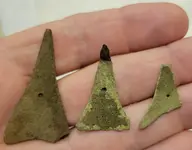D
Deleted member 140734
Guest
- #1
Thread Owner
While metal detecting on Eastern Long Island, NY I have discovered three copper kettle arrowheads over an approx. one year period. All in the same general area on a large piece of private property where I have obtained permission to detect. I was very excited. The contact period was brief. By the first decades of the 1700's most of Long Island's Native Peoples had succumbed to smallpox. While the use of copper may have advanced stone age implements, I'm sure Native cultures wanted to quickly progress to black powder firearms,
I have two Native American "Indian" Museums in my area. I wrote to one sharing my discovery and included my Archaeological credentials. I am currently a non-practicing archaeologist who has a graduate-level background, has worked in the field professionally, and have submitted reports to NY State. Months passed without reply. If I was not taken seriously because of being a avocational archaeologist with a metal detector, then I'm mad. And should be.
I recently wrote to the second Indian Museum in my area. They were excited and got right back to me. They wanted to send a photographer and meet me personally. NYS archaeologists. To their knowledge, only one copper kettle point has ever been found on Eastern Long Island. I appreciated the mutual respect and interest. I gifted them to their museum on Indigenous (Columbus) Day. Even better, they have been working on publishing a book of regional projectile points. My copper points will now be featured. I've also reached out to others I know who have local arrowhead collections to arrange documentation for the new book. (My largest point was near perfect until someone I was showing to dropped it on a concrete floor and broke the corner off!)
There you have it. Yet another example of metal detectorists contributing to scientific research.
I have two Native American "Indian" Museums in my area. I wrote to one sharing my discovery and included my Archaeological credentials. I am currently a non-practicing archaeologist who has a graduate-level background, has worked in the field professionally, and have submitted reports to NY State. Months passed without reply. If I was not taken seriously because of being a avocational archaeologist with a metal detector, then I'm mad. And should be.
I recently wrote to the second Indian Museum in my area. They were excited and got right back to me. They wanted to send a photographer and meet me personally. NYS archaeologists. To their knowledge, only one copper kettle point has ever been found on Eastern Long Island. I appreciated the mutual respect and interest. I gifted them to their museum on Indigenous (Columbus) Day. Even better, they have been working on publishing a book of regional projectile points. My copper points will now be featured. I've also reached out to others I know who have local arrowhead collections to arrange documentation for the new book. (My largest point was near perfect until someone I was showing to dropped it on a concrete floor and broke the corner off!)
There you have it. Yet another example of metal detectorists contributing to scientific research.




